
Apricot Folk - Maypole Dancing
Maypole Dancing Guide
Maypole Dancing - A Brief History
A Brief HistoryMAY For many generations, the arrival of
the warm months of summer has been celebrated by collecting bushes or
garlands of flowers and greenery and the raising of maypoles. Such
customs are found all over northern Europe, as well as America and
further afield. In England, there are many early references to May
festivities May bushes are first recorded in England in the 1200s and the earliest references to maypoles in southern England start around 1350. The celebration of May reached its height in the 1500s. Young men and women went out on the public holiday of the Feast of the Apostles Philip and St James the Less (May morning) to collect garlands to place on houses and in churches. The favourite foliage was usually whitethorn which is flowering hawthorn. This is the ‘may’ of the old saying “ne’er cast a clout ‘til may is out” (i.e. in blossom). Processions were held to celebrate the bringing of maypoles into cities, towns and villages accompanied by morris dancers and Robin Hood plays. |
||
|
EARLY MAYPOLES Custom dictates that maypoles should be ‘drawn home from the woods’ and set up in a public place. Usually the maypole would come from the estate of a ‘gentleman’ who would ‘grant’ the tree to the community. It was a local patronage given by the local gentry that seems to have continued until the 18th century. Traditional maypoles were, therefore as slender and tall as the fir trees they were often cut from. Decked with green boughs and fresh spring flowers they would be carried on a decorated cart in procession and erected in a prominent place in the community. In the City of London, in the early 1500s, the church of St Andrew, Cornhill was dominated by the higher shaft of the neighbouring maypole and so acquired the name St Andrew Undershaft, meaning under the maypole. |
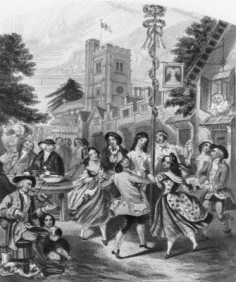 |
|
|
PURITAN INFLUENCES It is often thought that maypoles were pagan symbols of fertility in which strings consisting of vines knotted together to form a long leafy ribbon would be plaited by young maids in the first bloom of their womanhood in a rite to ensure the fertility of the land and its people. However, there is no evidence to support this. The earliest sources suggest that the maypole acted as a focal point for the May festivities or games and marked the place where everybody should meet. There is no evidence that they were connected to pagan beliefs or worship. Such accusations were first made by 16th century Puritan reformers who did not like any form of dancing, drunkenness and merry-making which they associated with idolatry. Here is an account by the Puritan Philip Stubbs in 1563 : Against May, Whitsonday, or other times, all the young men and maides, olde men and wives, run gadding over night to the woods, groves, hils and mountains, where they spend all the night in pleasant pastimes; and in the morning they return, bringing with them birch and branches of trees to deck their assemblies withal. And no mervaile for there is a great Lord present among them, as superintendent and Lord over their pastimes and sportes, namnely Sathan, prince of hel. But the chiefest jewel they bring from thence is their May-pole, which they bring home with great veneration, as thus. They have twenty or forty yoke of oxen, everyone having a sweet nose-gay of flowers on the tip of his hornes, and these oxen draw home this May-pole (this stynkyng ydol, rather), which is covered all over with floures and hearbes, bound round about with strings, from the top to the bottome, and sometime painted with variable colours, with two or three hundred men, women and children following it in great devotion. And thus being reared up, with hand kerchiefs and flags hovering on the top, they strew the ground round about, bind green boughs round about it, set up summer hauls, bowers and arbours hard by it. And then they fall to dance about it, like as the heathen people did at the dedication of the idols, whereof this is a perfect pattern, or rather the thing itself. I have heard it credibly reported (and that viva voce) by men of great gravity and reputation, that of forty, three score or a hundred maidens going to the wood overnight, there have scarcely been the third part of them returned home again undefiled Consequently, during the Protestant reign of Edward VI (1547—53), the May Day customs were curtailed. This became a cultural battleground in the Elizabethan period, and many Puritans were rebuked by public officials for their attempts to stop the Whitsun Ales, morris dancing and May Day games, as evidenced by this incident in Banbury in 1589 Richard Wheatley, the Constable of Banbury (a notoriously Puritan town), ordered William Long, Constable of Neithrop and Calthorpe to take down all maypoles in his district and ensure that he suppressed all entertainments such as May games, Whitsun ales, morris dancing, wakes and fairs. John Danvers, the Sheriff heard what was happening and wrote to the Lord Chancellor that he had informed the Archbishop of Canterbury that Anthony Cope of Hanwell Castle and other Banburians were using religion as an excuse for banning pastimes and that the local people were not pleased, causing disorder. He wanted the matter taken up by Queen Elizabeth’s Council. Anthony Cope claimed that Mr Danvers was being malicious and that restraint of Whitsun ales and morris dancing was not only nothing to do with him, but that any disorder in Banbury was engineered by Mr Danvers The Council duly considered the matter and wrote to Lord Norris saying that it had heard about the disorder in Banbury caused by the destruction of the maypoles and condemnation of their pastimes, and could find no objection to the pastimes as long as they were not used as an excuse for unlawful meetings. John Danvers wrote: “John Danvers, Sheriff of Oxford, to all Justices of the Peace and other officers in that County. Order to repress all riots and tumults that may be raised under pretence of taking down maypoles, which is being well used, and the time of Divine Service duly observed, were lawful to be kept.” |
||
|
Although the Stuart monarchs seemed to have no objection to maypole customs, continuing Puritan opposition resulted in the use of maypoles being banned by Act of Parliament under Cromwell. Local officials who did not comply could be fined 5 shillings a week. Not all communities took kindly to their traditions being interfered with. In Oxfordshire, over 12 maypoles were raised and morris sides as well, although these dwindled to only 1 or 2 maypoles in subsequent years. |
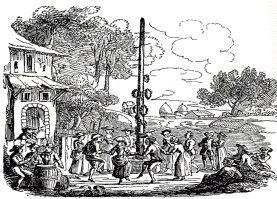 mid 19th century engraving |
|
|
REVIVAL May customs were brought back with great enthusiasm after the restoration of Charles II when General Wade raised a maypole in 1661 on The Strand in London to celebrate the king’s return to the capital. This particular maypole was 134 feet high. (The fate of The Strand maypole was to be bought by Sir Isaac Newton in 1717 and used to support his great telescope in Essex!). So it was that the tradition of raising maypoles to celebrate royal anniversaries began in the 17th century. Maypoles were raised in 1760 to celebrate the accession of George III. Also on 1887 and 1897 to celebrate the anniversaries of the reign of Queen Victoria and again in 1977 and 2002 for Queen Elizabeth II May customs and maypoles were brought into the towns and cities during the Industrial Revolution of the 18th and 19th centuries, but some were already in decline. Those which were rotted or blown down were not replaced. Yet even as the May traditions began to fade, they were again revived as part of the cult of ‘Merrie England’ |
||
|
RIBBONS These days maypoles are always associated with ribbons, but this, in fact, is a fairly recent development, and an interesting one. The high maypoles were never intended to have ribbons attached to them, it would have been impractical. The most usual form of dance round or near the maypole would probably have been the morris, although how similar this was to today’s morris is unclear. The Victorians were much attracted by the idea of the rustic idyll and this led to outdoor displays of a theatrical kind in the pleasure gardens and parks of the time. It seems that these displays included maypoles, morris dancers and ribbon plaiting. The dancers were probably professionally trained by ballet masters and were performing for an audience that wanted to re-create the nostalgic make believe land of ‘Merrie England’. The ribbon plaiting idea was probably borrowed from other European traditions. There is a picture in a 1858 edition of the Illustrated London News showing a picture of a high pole with ribbons attached about half way up and what looks like 24 dancers, both men and women circling clockwise and making a pattern like the Barber’s Pole. In the last half of the 19th century, ribbon plaiting round a maypole was therefore incorrectly seen as belonging to a romanticised English past. Sometimes, because of the cost involved in hiring professional dancers, some local dancers were trained to perform, and instead of men dancing the morris, there developed the custom of using young women to perform. So in the later years of the 19th century, maypole dancing with ribbons was accepted and known in scattered areas around the country and the scene was set for the next stage of development. |
 Children of Stadhampton School performing at Chiselhampton House, Oxon, 1st May 1904 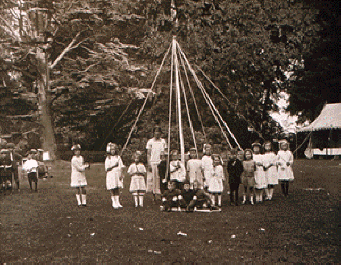 Aynho schoolchildren dancing at Aynhoe Park, Northants in 1930s |
|
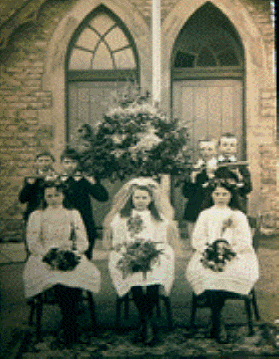 May Queen at Aynho School 1913 |
WHITELANDS COLLEGE Whitelands College, Chelsea, was a teacher training college for women teachers. Today it is part of the Roehampton Institute. In 1881, John Ruskin, the wealthy Victorian author and art critic, encouraged the Rev F J Faunthorpe, Principal of Whitelands College to initiate an elaborate May Queen ceremony. Such a ceremony had long been one of Ruskin’s ‘romantic fancies’, and the idea of a young, pretty unmarried, yet educated woman being crowned for a day echoed the Victorian ideals of what womanhood should be about. The Queen was to be chosen by fellow students because she was the “likeablest or nicest” and Ruskin gave her forty of his own books, printed on hand-made paper, richly bound with gold-leaf edges which she could then distribute to her favourites as “royal bounty”. He also gave her a gold cross, decorated with hawthorn flowers and hung from a gold chain as a personal gift. (As it happened, the very first Queen chosen was in mourning and caught the college unprepared. Her sombre black dress had to be hastily adorned with a light shawl and elaborate garlands of flowers). A picture from the college archives, dated 1889, shows a maypole with ribbons, dancing in costume, attendants using garlands, flowered head-dresses and May Queens looking like brides. |
|
|
In 1884 John Curwen and Sons published the earliest instructions yet found for maypole dancing and it is basically these dances which are used by Whitelands College students and in schools throughout the country. The dances are often still performed in the same order as they were printed in the early book. There is a limit to the number of ways you can dance round a central pole if you are attached by a ribbon, but over the years interesting new ideas or variations on an old theme have surfaced. It is obviously difficult to gauge how much the spread of ribbon dancing round a maypole in English schools is as a result of the teachers trained at Whitelands College. All that can be said with any certainty is that Ruskin’s ‘romantic fancy’ has survived for over a century and shows no sign of ending. Although not an indigenous tradition, over the last century, many schools have created their own versions of a May Day celebration and many include ribbon dancing. How many years it takes for something to become acceptable as a ‘tradition’ is debatable, but over 100 years of usage could no doubt be considered sufficient. |
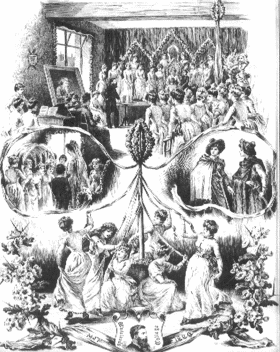 Picture from Whitelands College archives |
|
|
ACKNOWLEDGEMENTS Mayday to Mummers Christine Bloxham (Wychwood Press) Dancing Round the Maypole Diana Jewitt (EFDSS) A History of Maypoles Otley Maypole (Otley Project) |
||